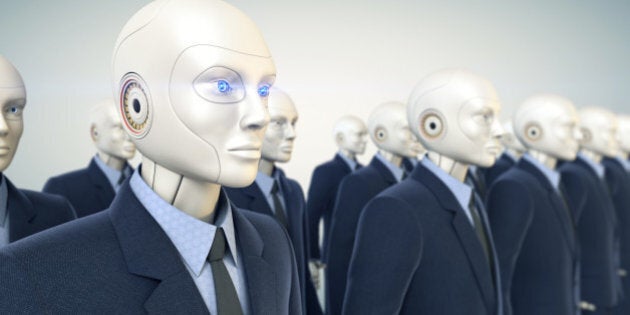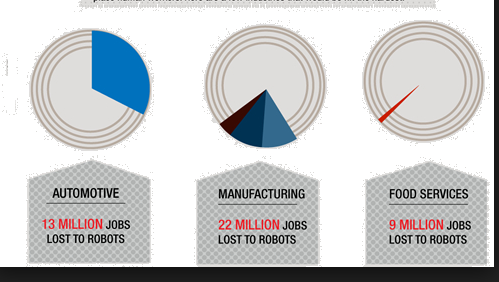

Jobs by 2025, source: International Federation of Robotics.
Are our workforces and economies ready to face the challenges of automation?
Nearly half of total North American employment is at risk of replacement by automation or computerization, according to a recent study by Oxford researchers.
The trend even has a new name: autonomics. The current generation of robots and automation can "think" and "learn" in limited ways. This make it capable of doing many more jobs that human beings do at present.
For example: In Canada, at the University of Toronto, a robot named Brian is already being used to care for the elderly, an area of rising need as the population ages. He gently reminds seniors, whose attention can stray, to eat their lunch. He can play memory games with them and suggest recipes. He can recognize emotions and adjust conversations and other interactions accordingly. And Brian costs just a few thousand dollars, a fraction of what a care worker earns in a year.
This is not a science-fiction scenario, something out of Battleship Galactica; this is cold, hard economic fact. There are already about 1 million robots in the workplace in the U.S., and with robotic skill-sets continually improving, more and more jobs in manufacturing and service industries can be replaced by automation.
Previously, only jobs in manufacturing were seriously impacted by automation, but as the abilities and skills of robots have been improved, they can now take on jobs in services as well. Robots can now take on a variety of tasks involving the interpretation of instructions.
Robots can drive cars. Rapid improvement in vision and touch technologies is putting a wide array of manual jobs within the abilities of robots. Robots can work closely with human beings without becoming a danger to them. They pack shipments at wholesalers. They clean and wash in homes.
But this is only the beginning. The means to automate higher skills levels is increasingly within coming into practice. Moore's law long ago described how quickly growth in computing power takes place -- so quickly, that before we have become accustomed to the present, the future is already happening. This means that more adaptable, "smarter," robots will soon move into jobs that require increased skill levels.
High-paying, high-skill service jobs like legal research and radiology imagery analysis are already beginning to be served by robots. The question is not if, but when the exponential growth of computing technology will allow for jobs that may be viewed as safe from automation to be taken over.
What about retraining workers to take over jobs with much higher levels of skills? Don't count on it. According to the Institute for Robotic Process Automation, it is the jobs in the middle of the job market -- those for ordinary college graduates and middle level business training -- that are being wiped out. These workers do not have the skills to move up to the higher end of the job market where most of the job creation is taking place.
Economist Richard Posner explains the effect of the driverless car on the national economy: "...This technology is advancing very rapidly and has great promise for reducing labor costs (drivers), traffic accidents (for example by eliminating drunk driving), traffic violations, and traffic jams (by optimizing speed, lane usage, and choice of routes and times)".
There are approximately 4 million truck, taxi, limousine and bus drivers in the United States, not to mention gas station attendants and traffic policemen. Not all these jobs will be eliminated overnight, but they could go quite fast.
It would be wrong, however, for policymakers to demonize the robotics industry, which is a purveyor of growth. It is rather their mandate to take the decisions necessary to help the moribund segments of the workforce get back to work again.
Policymakers must invest in education, innovation and discovery, so that our workforces, and our economies, can maintain their long term viabilities. In essence, we must invent new jobs for tomorrow.